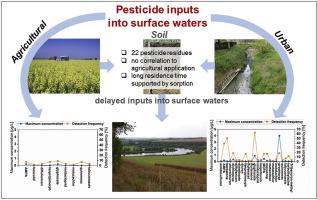Environmental Pollution ( IF 7.6 ) Pub Date : 2020-07-11 , DOI: 10.1016/j.envpol.2020.115186 Nadine Tauchnitz 1 , Florian Kurzius 2 , Holger Rupp 3 , Gerd Schmidt 4 , Barbara Hauser 5 , Matthias Schrödter 1 , Ralph Meissner 3

|
Pesticide inputs into surface waters may cause harmful effects on aquatic life communities and substantially contribute to environmental pollution. The present study aimed at evaluating the input pathways in the Querne/Weida catchment (central Germany) to efficiently target mitigation measures of pesticide losses. Relevant pesticide substances were measured in surface waters in agricultural and urban surroundings and in soil samples within the catchment area. Pesticides application data from farmers were analyzed. Additionally, batch tests were performed to determine sorption and degradation of relevant pesticides for site specific soil properties. Frequency of detection, number of pesticides and maximum concentrations were much higher in the surface water samples in mainly urban surroundings compared to those in agricultural surrounding. The most frequently detected substances were glyphosate, AMPA, diflufenican and tebuconazole in surface water samples and diflufenican, boscalid, tebuconazole and epoxiconazole in the topsoil samples. Glyphosate and AMPA contributed to the highest concentrations in surface water samples (max. 58 μg L−1) and soil samples (max. 0.19 mg kg−1). In most cases, pesticide detections in surface water and soil were not consistent with application data from farmers, indicating that urban sources may affect water quality in the catchment area substantially. However, it was observed that pesticide substances remain in the soil over a long time supported by sorption on the soil matrix. Therefore, delayed inputs into surface waters could be suspected. For the implementation of reduction measures, both urban and agricultural sources should be considered.
Novel findings of the study: pesticide detections were not consistent with application data from farmers, urban sources contributed substantially to pesticide pollution of surface waters.
中文翻译:

农业和城市来源对地表水中杀虫剂投入的评估-以德国中部Querne / Weida流域为例。
向地表水中输入农药可能会对水生生物群落造成有害影响,并极大地造成环境污染。本研究旨在评估Querne / Weida流域(德国中部)的输入途径,以有效地针对缓解农药损失的措施。在农业和城市环境的地表水以及集水区内的土壤样品中测量了相关农药物质。分析了农民的农药施用数据。此外,还进行了分批测试,以确定针对特定地点土壤特性的相关农药的吸收和降解。与农业地区相比,主要城市地区的地表水样品的检测频率,农药数量和最大浓度要高得多。最常检测到的物质是地表水样品中的草甘膦,AMPA,二氟苯醚和戊唑醇,表土样品中的二氟苯醚,硼硅酸盐,戊唑醇和环氧康唑。草甘膦和AMPA导致地表水样品的最高浓度(最大58μgL-1)和土壤样品(最大0.19 mg kg -1)。在大多数情况下,地表水和土壤中农药的检测与农民的应用数据不一致,这表明城市水源可能会严重影响集水区的水质。然而,据观察,农药物质在土壤基质上的吸附支持了很长时间。因此,可以怀疑地表水输入延迟。为了实施减排措施,应同时考虑城市和农业资源。
该研究的新发现:农药的检测与农民的施用数据不一致,城市来源对地表水的农药污染做出了重大贡献。











































 京公网安备 11010802027423号
京公网安备 11010802027423号